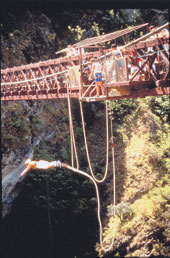 |
How would you like to jump off a suspension bridge 500ft above the Bhoti Kosi River? The Nepalese advertise it as the highest bungee jump in the world and anyone who has the nerve can get a great view of the fast-flowing mountain river and the gorges all around as they hurtle to the ground.
Bored with your normal nine-to-five existence? Why don?t you try bungee jumping, the adventure sport that probably produces enough adrenaline around the globe to fire a space rocket?
Bungee jumping started life as a tribal ritual with the people of Pentecost Island in Vanuatu in the Pacific. Modern bungee jumping began with four simultaneous jumps off the Clifton Suspension Bridge in Bristol, England, in 1979.
Anyone who thinks it?s just a freefall should think again. There are several types of jumps allowed such as the swallow dive, back dive and railing jump. Also, there are other classified as extremely dangerous. But overall, bungee jumping in considered a ?safe? sport and the one above the Khosi advertises that all precautions have been taken.
Good quality equipment plays an important role in bungee jumping, since it involves the jumper being thrown off a high point with a rope tied to a harness around his body that pulls him back up once the rope has extended to its full length. The vines traditionally used by tribal practitioners of the sport have been replaced by special nylon and fibre ropes and harnesses and come in several varieties. Most people prefer a body harness or a leg harness. In a body harness, the jumper gets quite a bit of freedom to move around, with arms and legs free to flail around. The cord is normally attached to a point close to the belly (the centre of gravity), making spins and flips easier.
These days, the equipment and safety standards have become so good that many operators offer slightly riskier jumps, such as water touchdowns. The jumpmaster has to be confident enough to judge how much the cord will stretch before the jumper hits the water. You jump as normal, but at the bottom you go into water ? and you?d better try this only where the water you dive into is deep enough.
Bungee jumping operations take place all around the world, from the US and Canada to the UK and several new locations in south Asia. Several adventure tour operators have now started cashing in on the popularity of the sport and set up operations in countries such as China, Indonesia, Malaysia, Philippines and Singapore. Nearer the sub-continent, Nepal and Sri Lanka are two countries that offer world-class bungee jumping facilities.
The sport?s popularity is growing in China with regular jumps organised by the giant Shanghai Bungee International. In Hong Kong, you have Bungy Zone Adventures in Kowloon run by A J Hackett Bungy that also runs operations in several locations in India such as the Kanteerava Stadium in Bangalore, as well as in Hyderabad, Mumbai, Pune, Chennai and Cochin.
In Singapore, you?ve got to go in for the reverse bungee organised by G-Max Reverse Bungee at Clarke?s Quay. In this take on bungee jumping, ?jumpers? can actually feel like human slingshots as they are thrown up instead of down. This is done by tying jumpers between two impossibly stretched ropes and flinging them up.
Although bungee jumping isn?t big in India there are some operators offering jumps (see box). Says Sunil Roy of Vertigo Expeditions, a Bangalore adventure travel company, ?Not too many operators are willing to get into this, as the equipment costs can run pretty high. Also, very strict safety guidelines have to be followed and permits obtained before setting up operations and this puts some operators off.?
Still, the number of people showing interest in bungee jumping is constantly on the rise, says Roy. As Indians get more and more interested in adventure sports and travel, this favourite pastime of the Pentecost islanders is sure to find more enthusiasts hoping for excitement in mid-air.











